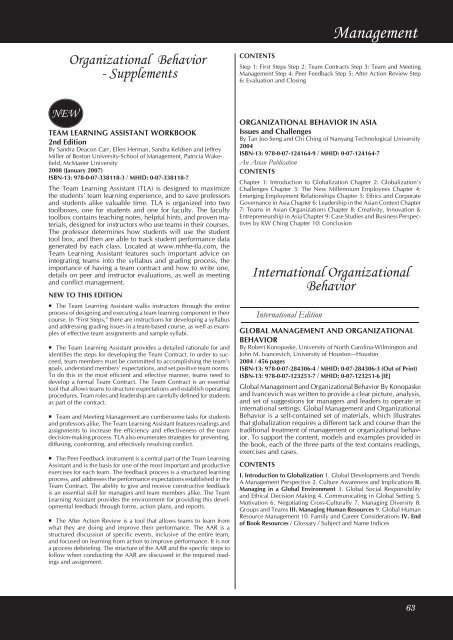Business Communication - McGraw-Hill Books
Business Communication - McGraw-Hill Books
Business Communication - McGraw-Hill Books
Create successful ePaper yourself
Turn your PDF publications into a flip-book with our unique Google optimized e-Paper software.
Organizational Behavior- SupplementsCONTENTSManagementStep 1: First Steps Step 2: Team Contracts Step 3: Team and MeetingManagement Step 4: Peer Feedback Step 5: After Action Review Step6: Evaluation and ClosingNEWTEAM LEARNING ASSISTANT WORKBOOK2nd EditionBy Sandra Deacon Carr, Ellen Herman, Sandra Keldsen and JeffreyMiller of Boston University-School of Management, Patricia Wakefield,McMaster University2008 (January 2007)ISBN-13: 978-0-07-338118-3 / MHID: 0-07-338118-7The Team Learning Assistant (TLA) is designed to maximizethe students’ team learning experience, and to save professorsand students alike valuable time. TLA is organized into twotoolboxes, one for students and one for faculty. The facultytoolbox contains teaching notes, helpful hints, and proven materials,designed for instructors who use teams in their courses.The professor determines how students will use the studenttool box, and then are able to track student performance datagenerated by each class. Located at www.mhhe-tla.com, theTeam Learning Assistant features such important advice onintegrating teams into the syllabus and grading process, theimportance of having a team contract and how to write one,details on peer and instructor evaluations, as well as meetingand conflict management.NEW TO THIS EDITION• The Team Learning Assistant walks instructors through the entireprocess of designing and executing a team learning component in theircourse. In “First Steps,” there are instructions for developing a syllabusand addressing grading issues in a team-based course, as well as examplesof effective team assignments and sample syllabi.• The Team Learning Assistant provides a detailed rationale for andidentifies the steps for developing the Team Contract. In order to succeed,team members must be committed to accomplishing the team’sgoals, understand members’ expectations, and set positive team norms.To do this in the most efficient and effective manner, teams need todevelop a formal Team Contract. The Team Contract is an essentialtool that allows teams to structure expectations and establish operatingprocedures. Team roles and leadership are carefully defined for studentsas part of the contract.• Team and Meeting Management are cumbersome tasks for studentsand professors alike. The Team Learning Assistant features readings andassignments to increase the efficiency and effectiveness of the teamdecision-making process. TLA also enumerates strategies for preventing,diffusing, confronting, and effectively resolving conflict.• The Peer Feedback instrument is a central part of the Team LearningAssistant and is the basis for one of the most important and productiveexercises for each team. The feedback process is a structured learningprocess, and addresses the performance expectations established in theTeam Contract. The ability to give and receive constructive feedbackis an essential skill for managers and team members alike. The TeamLearning Assistant provides the environment for providing this developmentalfeedback through forms, action plans, and reports.• The After Action Review is a tool that allows teams to learn fromwhat they are doing and improve their performance. The AAR is astructured discussion of specific events, inclusive of the entire team,and focused on learning from action to improve performance. It is nota process debriefing. The structure of the AAR and the specific steps tofollow when conducting the AAR are discussed in the required readingsand assignment.ORGANIZATIONAL BEHAVIOR IN ASIAIssues and ChallengesBy Tan Joo Seng and Chi Ching of Nanyang Technological University2004ISBN-13: 978-0-07-124164-9 / MHID: 0-07-124164-7An Asian PublicationCONTENTSChapter 1: Introduction to Globalization Chapter 2: Globalization’sChallenges Chapter 3: The New Millennium Employees Chapter 4:Emerging Employment Relationships Chapter 5: Ethics and CorporateGovernance in Asia Chapter 6: Leadership in the Asian Context Chapter7: Teams in Asian Organizations Chapter 8: Creativity, Innovation &Entrepreneurship in Asia Chapter 9: Case Studies and <strong>Business</strong> Perspectivesby KW Ching Chapter 10: ConclusionInternational OrganizationalBehaviorInternational EditionGLOBAL MANAGEMENT AND ORGANIZATIONALBEHAVIORBy Robert Konopaske, University of North Carolina-Wilmington andJohn M. Ivancevich, University of Houston—Houston2004 / 456 pagesISBN-13: 978-0-07-284306-4 / MHID: 0-07-284306-3 (Out of Print)ISBN-13: 978-0-07-123251-7 / MHID: 0-07-123251-6 [IE]Global Management and Organizational Behavior By Konopaskeand Ivancevich was written to provide a clear picture, analysis,and set of suggestions for managers and leaders to operate ininternational settings. Global Management and OrganizationalBehavior is a self-contained set of materials, which illustratesthat globalization requires a different tack and course than thetraditional treatment of management or organizational behavior.To support the content, models and examples provided inthe book, each of the three parts of the text contains readings,exercises and cases.CONTENTSI. Introduction to Globalization 1. Global Developments and Trends:A Management Perspective 2. Culture Awareness and Implications II.Managing in a Global Environment 3. Global Social Responsibilityand Ethical Decision Making 4. Communicating in Global Setting 5.Motivation 6. Negotiating Cross-Culturally 7. Managing Diversity 8.Groups and Teams III. Managing Human Resources 9. Global HumanResource Management 10. Family and Career Considerations IV. Endof Book Resources / Glossary / Subject and Name Indices63HED 2007 Management.indd 6310/5/2006 1:24:16 PM

















